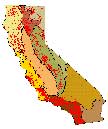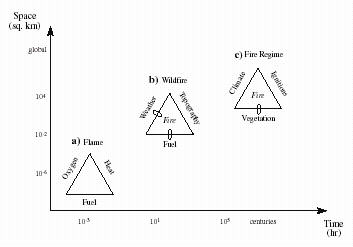|
The topic of my dissertation was "Controls on Disturbance Regime Dynamics: Fire in Los Padres National Forest," based on the analysis of its mapped fire history from 1911-1995. Although fire remains a central research theme, I am also interested in the general topics of ecosystem dynamics and management, biogeography, and conservation ecology. Here is a link to a version of my C.V.
| A fire regime is a complex phenomenon, driven by a variety of biotic and abiotic factors at several spatio-temporal scales. Fire is also one of the clearest examples of the linkage between "pattern and process" on the landscape. Over short timescales, fires generate spatial patterns of age classes and affect vegetation stand structures, all of which feed back to alter the likelihood and behavior of future fires. Over very long timescales, fires affect patterns of species composition in ecosystems, which also feed back to influence the regional fire regime. Based on historical data, there is a clear relationship between fire occurence and vegetation types that can support fire. |
|
|
It is often difficult to characterize the "natural" fire regime of an area, given multiple parameters of frequency, size, season, intensity, and types of fires — and this involves mean values of parameters, their ranges of variation, and how they interact with each other statistically. In addition to vegetation type and other fuels-related factors, fire regimes are driven by characteristics of climate and the location and timing of ignitions (see figure at left). |
Understanding how modern human activities have altered fire regimes is often crucial, because many vegetation types are adapted to certain fire regimes for their persistence. Although prescribed burning is an integral tool in restoring many fire regimes, burning in fire-dependent species of vegetation may be more complex than is currently understood. A recent prescribed fire in Montana de Oro State Park is a good example of how burning can have unintended negative consequences for native plant species.
Much of my research is focussed on understanding the dynamics of fire regimes at relatively broad scales. I have employed quantitative analyses of fire history, examining the relative importance of different mechanisms that drive fire patterns on the landscape. I am also interested in simulation of fire dynamics, using spatially-explicit models of fire spread and vegetation regrowth.
Fire History Analysis |
Prescribed Burning |
Fire Simulation |
|
[Research]
|
||
|
Last updated: <February, 2003>
|

